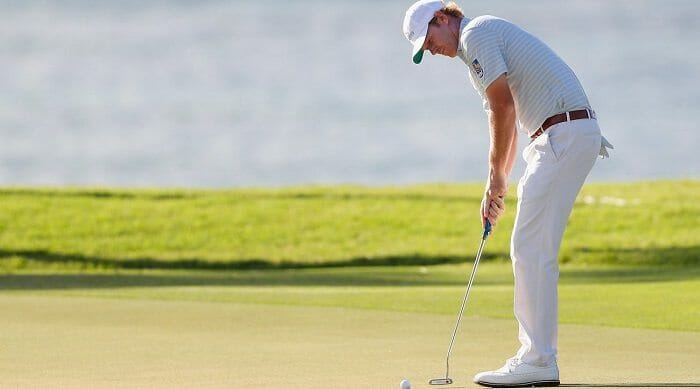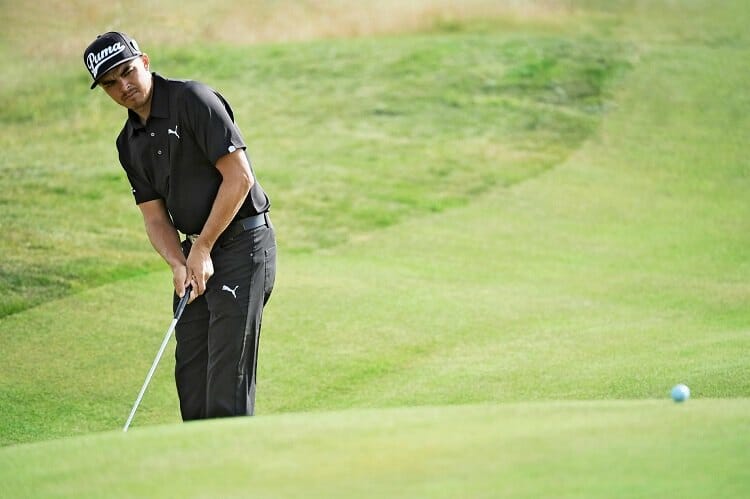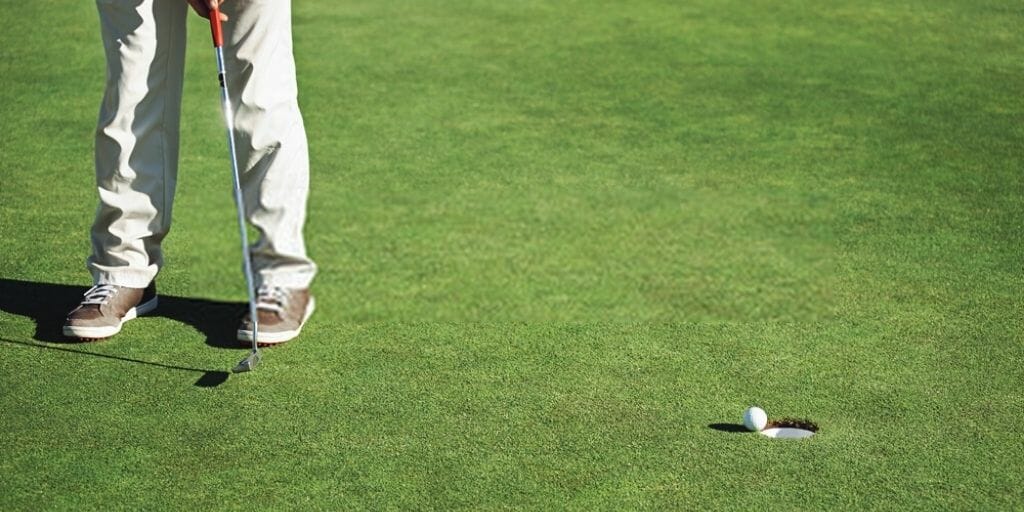In the game of golf, hitting long and straight drives consistently is like hitting the jackpot. If you have the ability to hit the ball long and straight every single time and find that fairway. Then you’re a champion on the golf course. However, many golfers neglect or downplay the importance of putting green.
Golf Putting Tips – How to Putt Better – This is an invaluable, very useful, and practical guide. For those who consider putting as a common source of irritation during their game of golf. After all, it’s not just your buoyant drives and perfectly-hit irons that benefit your score.
That said, it’s time to put your putting play into practice. Because, no doubt, it’s going to change once you reach the end of this article…
Top 5 Most Effective Golf Putting Tips

#1 Improve Your Impact
This is one of the most important putting stroke fundamentals. The aim is for getting the golf ball either slightly off or from a point on the green and into that hole. Even if the ball doesn’t get into the hole. You want to reach as close to it as possible.
For that to happen, your putting technique demands a little bit of improvement…
- Start the ball as close to the target line as possible.
- Control and modify the ball velocity felt on the face of the putter.
- Launch the ball off your putter face within the range of 1 and 4 degrees upwards.
- Be confident enough to functionally adapt during difficult situations.
#2 Minimize Clubface Variability At Impact
Not many beginners know that the putter clubface has a much greater effect on your start direction that you can imagine. This effect at impact is almost 5x more. And it’s greater on your start direction instead of the swing path.
So the goal here is to create a consistent stroke that starts your golf ball 0.5 degrees or less from the target line. You should make this a part of your putting stroke mechanics.
But if the ball starts at even 1 degree off the target line. It’s bound to be around 2.1 inches wide of the target once it reaches 3 meters i.e. 10 feet. So it’s going to hit either the left or right lip of that hole. This means at 2 degrees, the golf ball travels more than 4 inches off your target at the same 10 feet.
Therefore, you simply cannot hole putts consistently from within 10 feet. Not as long as you’re able to achieve a simple aim like this.
The goal for you at this point should be to reduce the putter face variability during impact. No matter how technically sound your putting stroke is. It’s going to be completely useless if you are pointing toward the wrong or incorrect direction.
#3 Improve Your Putting Grip

One of the best putting tips is to work on your putting grip. A great grip is one that returns the clubface of the putter squarely. That without conscious control or thought. Most golfers, especially newbies, tweak the grip of the long game just a bit for putting with. This is an error, no doubt.
So here’s how you can test the effectiveness of your putting grip for returning the clubface consistently squarely…
- With a normal setup, remove the trail hand. More often than not, this means the right hand.
- With the left one, i.e. lead hand on your putter, flex, and then extend the wrist.
- Check the extent to which clubface open and close rotation takes place with the movement.
- Repeat the same thing, but, for the second time, do it with the trail hand only.
If your grip is poor, then the clubface is sure to swing open and close viciously. Along with a tiny bit of your wrist movement. As for a great grip, it’s a result of the perfect connection between the club and your hands. At such times, any level of wrist extension or flexion doesn’t affect the face angle all that much.
#4 Perfect Your Putt Launch
Starting the golf ball on the intended line means being better at the task of putting than the majority of golfers. And the next step is to excel at the art of controlling your putt distance.
Start by hitting the putts off the center of a squarely positioned clubface. That said, it’s time now for you to check your putter lie during setup…
- Take your natural setup.
- Then tell someone to slide the scorecard below both ends of the putter head. Make sure there’s even space between the heel and toe of the putter.
Does it look like your putter is sitting properly? If not, then one end has a card that’s placed much farther. In that case, you’re complicating the already difficult task of putting for yourself.
#5 Assess Your Putt Launch Angle
As I’ve discussed, you want the ball to launch slightly upward, right? So for that to take place, two factors come into play.
- The putter loft at impact, known as the dynamic loft.
- The extent to which the putter head moves downward or upwards through impact.
The greater part of putters is equipped with a loft of 3-4 degrees. So for a quick roll, professional golfers use putters with a loft of only 1-2 degrees. You can also do the same simply by keeping your hands just a little ahead of that putter head during impact. This tends to de-loft your putter.
Now it’s time to combine this loft with a minimally upward strike. This may not impart topspin necessarily. But it surely does decrease any unwanted backspin when the golf ball is launched. Thus, the ball rolls as efficiently as it should. If you ask me, it’s one of the most useful golf putting tips for beginners.
Read more: How To Put Backspin On A Golf Ball
How to Putt Better – Top 3 Tour Secrets
1. Distance control for long putts

Let’s turn to Phil Mickelson for this one. This particularly talented professional golfer strikes his putts at a great speed. And here’s how his drill works.
The golfer picks a hole on that practice green. And he sticks 3 tees into the ground. One at 30 feet out, the second at 40 feet out, and the final one at 50 feet out. The goal here is to roll 3 putts consecutively from every tee into the imaginary 3-feet circle framing the hole.
Phil Mickelson begins at a 40-feet distance and putts till he achieves 3 successive hits. Then moves to 30 and then 50.
What does this tell you? That controlling distance is important when it comes to long putts. Once you’re able to judge the right speed. You’re more likely to achieve the second putt. But if your judgment is wrong, then you leave a distance of 10-12 feet.
For long putts, the stroke should be slightly slower and longer. Thus, adding that additional hit to the golf ball. As opposed to deliberately hitting the ball harder. And this, more often than not, leads to mishits. Instead think smooth and long. And let that clubhead accelerate through your golf ball.
You’re free to practice from more than just one angle. Such as the right to left putts when downhill. And left to right putts when uphill.
2. Keep the putting routine short and to the point

You can copy Sneds when it comes to how to approach your putts. Especially if you’re an average golfer. Simply because the pro gets on with the task at hand. Meaning once he decides what to do with his putt. He does not waste time. Otherwise, you end up increasing your stress levels. And the result of this, more often than not, is a lack or loss of confidence.
If you’ve ever seen Brandt, then you know how he reads his putts from behind that golf ball. Making tiny air strokes using his right hand. And then he steps in to make 3-4 short practice putting strokes. With his eyes fixed to the hole.
His every stroke has minimal follow-through and a faster pace. You should putt it exactly like that as well. Because this way you’re bound to hit the golf ball on that right line.
What I’m trying to say is keep your concentration simple. Read the putt, imagine a 3-inch or 4-inch trough from the golf ball to that hole. Your goal is to roll the ball down the trough. So don’t waste time staring at that ball. Instead, focus your eyes on the intended line. And then create a decent, firm strike down the line just like that.
To be honest, this is the only way you can learn how to putt better.
3. Lift the clubhead off the ground for short putts

How to putt for beginners? Let’s turn to Rickie Fowler for that. After all, this professional golfer is very famous for his shorter putts. And what he does best is lift the putter clubhead off the turf right before putting. Let me explain his overall approach below.
Rickie Fowler steps into his very putt keeping nothing but precise aiming of the putter clubface in mind. He sets the putter clubface using the right hand only. And completes the grip once the face of the putter is perfect. Then just one look at that hole and he fractionally raises the clubhead off the turf before starting back.
You can and should try this particular approach. And here’s why…
- It takes away all the unwanted tension from your arms and hands. And this is very beneficial when it comes to short putts.
- It creates an even, smooth backstroke. That too without the risk of the putter getting caught up on the grass.
Conclusion
So you’ve finally reached the end of Golf Putting Tips – How to Putt Better.
The thing about how to putt better is that you have to practice. And you also have to keep in mind that great putters have that confident going-in body language. Give your full effort. And never talk yourself out of putts. What’s the worse that could happen if you do? You could either miss it or make it. As for the best putters out there, the latter is the only thing they’re thinking about.
There are many ways to improve your game of putting. After all, the swing you make is the simplest in golf. Plus, no need to deal with the rough, out-of-bounds, or bunkers. You putt on a smooth surface with your target right there. So ditch your negative attitude. And read that break, aim that clubface, and start your golf ball on that line. Just go for it!
Read more:
Matt Stevens is the founder of Golfrough.com. He holds a Postgraduate in Sports Marketing and has played golf since he was four years old. Having experienced every high and low golf has to offer, his writing helps the average golfer avoid the mistakes he has made in 28-years on the course.

